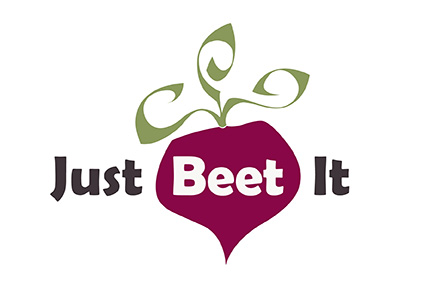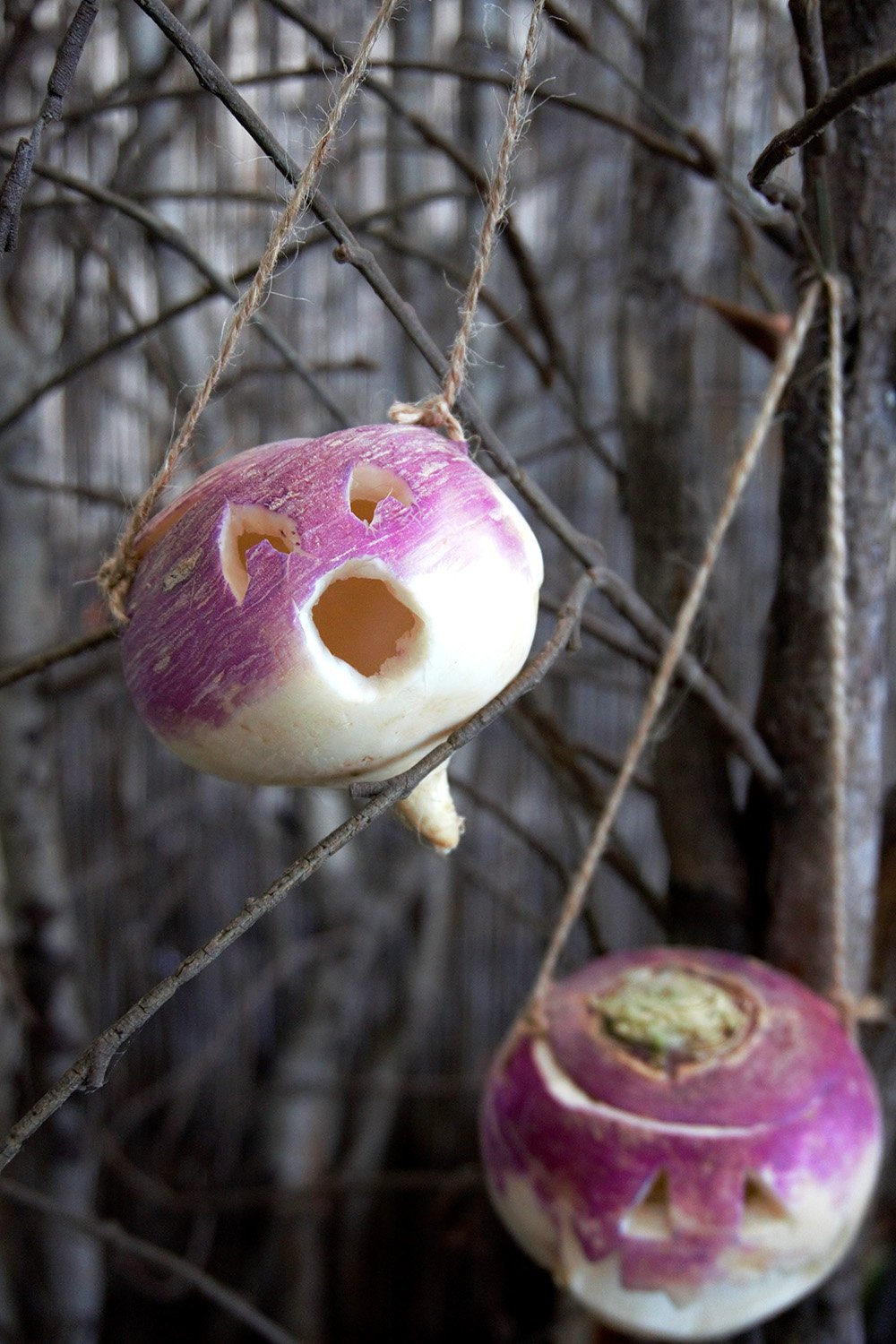Turnips and Beets and Potatoes, oh my! Want to make a truly terrifying and traditional jack-o’-lantern for Halloween this year? Carve a turnip! Did you know that turnips (not pumpkins) were the first jack-o’-lanterns?
Long before the charming pumpkin became our beloved canvas for carving at Halloween, the quirky turnip (also called a “Neep” or “Tumshie” or “Moot”) was carved. A Celtic tradition dating back to the 19th and early 20th centuries, jack-o’-lanterns first started when people carved grotesque and monstrous faces into turnips (and other root vegetables, such as potatoes and beets) and placed them on windows and doorsteps to ward off unwanted visitors and evil spirits.
WHY YOU SHOULD CARVE A TURNIP, BEET, OR OTHER ROOT VEGGIE JACK-O’-LANTERN
Turnips, beets, and other root vegetables make THE best and most interesting jack-o’-lanterns - even better than pumpkins. Gasp! Yes. I said it. Although a fan of pumpkin carving too, turnips take grisly and gnarly jack-o’-lanterns to the next level. Shriveled and shrunk, weathered and filled with character, turnip and root veggie jack-o’-lanterns can look creepier than pumpkins, like shrunken heads sitting on your stoop or hanging from the trees. Turnips have interesting skin and gnarly bumps and nobs and can really give out terrifying and gruesome vibes with their warty and monster-like appearances.
Even if you are planning to carve pumpkins this Halloween season, I encourage you to give a nod to the original tradition of jack-o’-lanterns and carve a turnip, potato, or beet! There is a myriad of root vegetables like beets, potatoes, celery root, and radishes that make delightfully ghoulish or charming Halloween jack-o’-lanterns. Don’t forget to save the carved innards to make a hearty broth or root vegetable stew.
WHAT IS A HALLOWEEN JACK-O’-LANTERN, AND WHY DO WE CARVE THEM?
Most people are familiar with the tradition of carving a jack-o’-lantern pumpkin for Halloween, a carved pumpkin with a light inside commonly associated with Halloween festivities and named from Irish folklore. Although macabre in nature, carving pumpkins is an old Halloween tradition. There are pumpkin carving contests and parties - all celebrating this tradition of carving scary, artistic, or funny faces on the outside skin of a pumpkin and lighting them with a candle or battery-operated tea light.
Pre-dating pumpkin carving, in Ireland and other parts of Europe, turnips (not pumpkins) were carved as a way to keep away evil spirits. Ireland didn’t have pumpkins, but they had a surplus of turnips, potatoes, and beets (mostly sugar beets). Since metal lanterns were expensive, people hollowed out root vegetables and added a candle. Carving faces allowed light to shine through without extinguishing the ember - making it a brilliant lantern to light the way in the dark AND to scare away any potential wandering spirits.
THE INTERESTING HISTORY OF JACK-O’-LANTERNS STARTED WITH TURNIPS (MOOTS, NEEPS, OR TUMSHIES)
The Irish folklore of turnip carving as Jack-O’-Lanterns originates from a story about a man named Jack (also known as “Stingy Jack”) who tricked the devil and was cursed to roam the earth in “eternal night” with only a burning coal as his light. Jack placed the coal into a carved-out turnip and carried it as his lantern roaming the earth forever. Irish folklore refers to this ghostly figure as “Jack of the Lantern” and as we now call it, “Jack-O’-Lantern.”
Turnip jack-o’-lanterns were traditionally carved in Ireland, Scotland, and England, most likely as part of the Pagen festival Samhain which marked the beginning of winter. Ancient Celts believed that during Samhain the veil between the living and the dead was at its most vulnerable (Smithsonian Magazine).
In the British Isles, the traditional celebration of Hop Tu Naa takes place on October 31st and involves dancing, carved turnip lanterns, pranks, etc. In various parts of Europe, large potatoes and beets rather than turnips are used for carving jack-o’-lanterns. In France, on the eve of Toussaint (All Saints Day: November 1st), large sugar beets are carved, and with a small candle inside, are placed on the windowsills.
Halloween as celebrated in the United States and throughout various parts of the world originates from Celtic history. Emigrants from Ireland and Scotland came to America and brought their custom of carving turnips around the end of October, and soon, the beloved orange pumpkin replaced the turnip. Pumpkin, a fruit native to North America, is more accessible and abundant. Although turnip carving is less commonly practiced and most countries now use pumpkins to carve during Halloween, a few countries like Scotland still carve turnips (“Tumshies” or “Moots”) for Halloween. Looking for an awesome gift idea for your kiddos, check out this educational and festive children’s book Tumshie, The Forgotten Halloween Turnip Lantern by Mark Mechan.
If pumpkin carving is part of YOUR Halloween tradition, I highly encourage you to also carve a few turnips and other root vegetables. Meet my ragtag root veggie family of Jack-O’-Lanterns!
ROOT VEGETABLE JACK-O’-LANTERENS USING TURNIPS, BEETS, POTATOES, AND RADISHES
Which one is your favorite?
You can also add string to the lanterns and hang them outside on trees like these:
HOW TO CARVE A HALLOWEEN TURNIP (AND OTHER ROOT VEGETABLE) JACK-O’-LANTERN
You need large root vegetables (the quirkier and weirder looking the better), a strong spoon, a sharp knife, and some grit!
Although a fan of carving pumpkins too, root vegetable carving is really interesting and a different experience from pumpkin carving. I am hooked! I tend to lean into the weird and monster-like faces over terrifying and gruesome expressions (see pics below) but whatever you choose, you will enjoy the outcome.
Scooping out the innards with a spoon is more traditional (and how I choose to remove the inside of the vegetables), but you can speed things up with a drill or wood chisel if you prefer. For zero waste - save the vegetable flesh for a delicious stew or root vegetable broth.
You should be able to find turnips (also known as Swedish Turnip, Rutabaga, Moot, Tumshie, or Neep, - depending on your location) and other root vegetables in your local markets. You can also try to source them at a farmers’ market (if they are active this time of year) or grow them in your garden if your weather allows!
Materials You Need:
Large turnip or other root vegetable
Sharp kitchen or paring knife
Non-porous cutting board
Strong metal spoon
Pencil, pen, or toothpick
Pumpkin carving saw kit (optional)
Battery-powered tea light
1. Use the biggest turnips and other root veggies you can find. The veggies should be large enough to hold a tea light.
2. Turnips and beets are dense vegetables. They aren’t necessarily more difficult to carve than pumpkins, but their flesh can be a little denser to remove (however, you don’t have to deal with the messy insides of a pumpkin!). You can use a chisel or a drill, but if you have a little patience and gumption, carving turnips and beets traditionally with a spoon and small knife is worth the effort.
3. Decide which portion will be the front (I like to feature the weirdest nobs, warts, and skin texture for the face), and then cut out the bottom creating a flat base for the turnip or root vegetable to stand. If you want to hang these lanterns (see pics below), then you don’t need to have a flat base for the bottom.
4. With a sharp kitchen knife, cut the top and save it as a cover for the lantern.
5. Then, begin scooping the insides and carving out the cavity of the vegetable. It helps to carefully cut around the whole inside of the vegetable before scooping and then scoop in sections.
6. After the insides are scooped out, carving is the same as carving a pumpkin. If you wish, use a pumpkin-carving saw or use a sharp paring knife (like I use) - just be careful!
7. If you prefer, draw a face with a pencil or make an indentation of the shape with a toothpick before carving. Because the canvas of turnips, beets, and radishes is typically smaller than a pumpkin, it takes a little patience to carve the smaller surface area.
8. Once carved, save the vegetable innards for a hearty stew and place your battery-powered tea light. Use battery tea lights over real candles as turnip lanterns are small, and the candle may heat the turnip causing it to spoil faster.
9. Turnip lanterns will last about 3-4 days indoors (depends on house temp); however, in colder temps, they may last longer outdoors. You can also place your lanterns in a loose bag and store inside the fridge overnight.
EXTRA NOTES:
I encourage you to experiment with all types of root vegetables; however, some are easier to carve and light than others. The potato was the easiest to carve, and I loved how it turned out, but it got mushy within a few days. The turnips and beets are denser and more challenging to carve, but they will last longer as jack-o’-lanterns.
Radishes add an extra shriveled creepy look to the mix, but they can be challenging to carve due to their small size and many are not large enough to hold a tea light. However, the small quirky size makes these radish lanterns look like shrunken heads, so if you can find one big enough to add a tea light, go for it!
Have fun carving your historical root jack-o’-lanterns and let me know how yours turn out! Tag me on Facebook or Instagram or comment below. Happy Halloween!
Consider sharing this on Pinterest. Thanks for the love!
YOU MAY ALSO LIKE
























